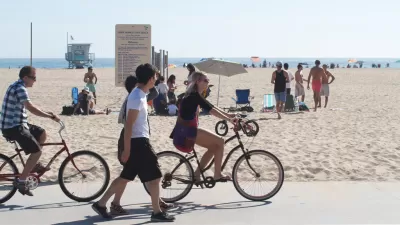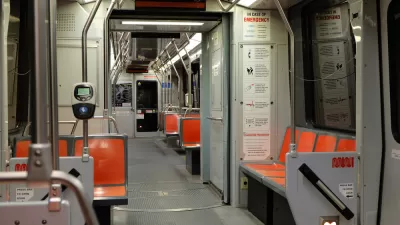California was the first state to require all residents to submit to a stay-at-home order, and it appears that Gov. Gavin Newsom wants to ensure it's not the last one to relax that order, regardless of whether it meets the federal guidelines.

"Gov. Gavin Newsom announced [on Monday, May 4] that some retail stores across the state can reopen with modifications as early as Friday amid growing pressure to ease the stay-at-home order that has cratered the California economy," report Taryn Luna and Phil Willon for the Los Angeles Times.
The new changes are part of a four-stage plan the governor laid out last week to gradually transition back to normal in a state of nearly 40 million people whose lives have been upended by the COVID-19 pandemic.
Under the new statewide COVID-19 guidelines, the governor said bookstores, music stores, toy stores, florists, sporting goods retailers and others can reopen for pickup, and manufacturing and logistics can resume in the retail supply chain.
"But California still has not seen the sustained 14-day decline in coronavirus cases the White House has suggested as a key criteria before easing stay-at-home orders," reports Rong-Gong Lin II for the Times on Tuesday, May 5.
The state reported its highest weekly coronavirus case total during April 20-26, with 12,122 cases. Last week, 9,967 cases were reported, an 18% decline, but last week’s case count was still the second-highest weekly total reported during the pandemic. [See bar graph in article].
One need only look at the state Department of Public Health COVID-19 dashboard to see that state is nowhere close to meeting the White House gating criteria specifying a "downward trajectory of documented cases within a 14-day period." Tuesday saw the largest one-day increase in cases, over 2,600. While deaths are not part of the criteria, it's clear that there is no downward trend, or in fact a trend of any kind, with 95 reported during the Wednesday briefing for May 5, the third-highest.
Santa Clara County
In a separate article, Lin II, reporting from Northern California, writes about resistance to easing up on stay-at-home restrictions in the Bay Area which were the first in the nation to issue such orders.
Santa Clara County’s executive officer cautioned Tuesday against moving quickly to lift the shelter-in-place order.
The death toll in California is still going up at significant numbers, Dr. Jeffrey Smith told the Santa Clara County Board of Supervisors Tuesday...“There’s a lot of talk in California about relaxing shelter-in-place [orders]. I just want to point out that we’re still, in California, going up dramatically. So there’s no clinical evidence that shelter-in-place [orders] should be relaxed at this point.”
Echoing statements by other medical experts, Smith said loosening up the stay-at-home orders will result in more infections and deaths.
The governor's plan gives wide discretion to individual counties to go slower or faster, providing they "first submit 'containment plans' that meet certain requirements for hospital beds, testing kits and the ability to track infected people and trace their contacts," wrote Luna and Willon, which was well-received by Arthur Reingold, division head of epidemiology and biostatistics at UC Berkeley.
“We have a very large state with very diverse counties, so this does need to be customized to a certain extent,” Reingold told The Mercury News. “The idea that all areas of the state would be opening all of the same things at the same time wouldn’t be very sensible to me.”
Los Angeles
Mayor Eric Garcetti (D-Los Angeles) also expressed unwillingness to loosen restrictions to the extent that Newsom will allow.
"Garcetti said he did not expect city businesses to be able to offer curbside delivery on Friday in step with Gov. Gavin Newsom’s comments," reported the Times on May 4. "The city’s Safer at Home order [pdf] is in effect until May 15, and Garcetti said he hoped steps restricting commerce could begin to be rolled back by then."
"Los Angeles County, home to 55% of California’s COVID-19 deaths despite having only one-quarter of the state’s population, saw its reported weekly death toll flatten for the first time: 315 deaths in each of the past two weeks," reports the Times on May 6.
Testing: No county is ready to open
A comprehensive analysis prepared by Palm Springs Desert Sun reporters Nicole Hayden and Mark Olalde found that "most of the U.S. and every county in California are woefully unprepared to reopen in accordance with public health recommendations." However, they didn't use the White House gating criteria referenced above.
A minimum of approximately 152 tests per 100,000 people must be administered daily around the country in order to monitor potential outbreak clusters or a second surge in the fall, according to research from the Harvard Global Health Institute [posted here]. Until then, it could be dangerous for governments to consider reopening.
"We are currently in the ‘it’s a wildfire’ phase, and the problem now is the fire is in large part invisible," said Dr. Michael Gunn, a professor of medicine and immunology at Duke University. "So, what testing does right now is gives us an idea of how bad the fire is and where is it located.”
California is far behind behind the national leaders — Rhode Island, North Dakota and New Mexico — which are respectively averaging about 260, 209 and 163 tests per 100,000 residents each day. No other states have yet to achieve the recommended testing metric when applied at a state level, though New York and Massachusetts are close.
The analysis looks at the current inadequate testing on county levels as well as shortcomings in Newsom's testing approach.
How is Newsom doing?
"Despite the vocal opposition in some parts of the state, recent polls show that the vast majority of Californians approve of how the governor is handling the coronavirus crisis and are more concerned about reopening too early than too late," add Luna and Willon in the source article.
Related in Planetizen:
- President Trump's Plan to Reopen the Economy Rests with States, April 20, 2020
FULL STORY: Gov. Gavin Newsom says reopening California will begin this week amid coronavirus crisis

Planetizen Federal Action Tracker
A weekly monitor of how Trump’s orders and actions are impacting planners and planning in America.

Chicago’s Ghost Rails
Just beneath the surface of the modern city lie the remnants of its expansive early 20th-century streetcar system.

San Antonio and Austin are Fusing Into one Massive Megaregion
The region spanning the two central Texas cities is growing fast, posing challenges for local infrastructure and water supplies.

Since Zion's Shuttles Went Electric “The Smog is Gone”
Visitors to Zion National Park can enjoy the canyon via the nation’s first fully electric park shuttle system.

Trump Distributing DOT Safety Funds at 1/10 Rate of Biden
Funds for Safe Streets and other transportation safety and equity programs are being held up by administrative reviews and conflicts with the Trump administration’s priorities.

German Cities Subsidize Taxis for Women Amid Wave of Violence
Free or low-cost taxi rides can help women navigate cities more safely, but critics say the programs don't address the root causes of violence against women.
Urban Design for Planners 1: Software Tools
This six-course series explores essential urban design concepts using open source software and equips planners with the tools they need to participate fully in the urban design process.
Planning for Universal Design
Learn the tools for implementing Universal Design in planning regulations.
planning NEXT
Appalachian Highlands Housing Partners
Mpact (founded as Rail~Volution)
City of Camden Redevelopment Agency
City of Astoria
City of Portland
City of Laramie





























